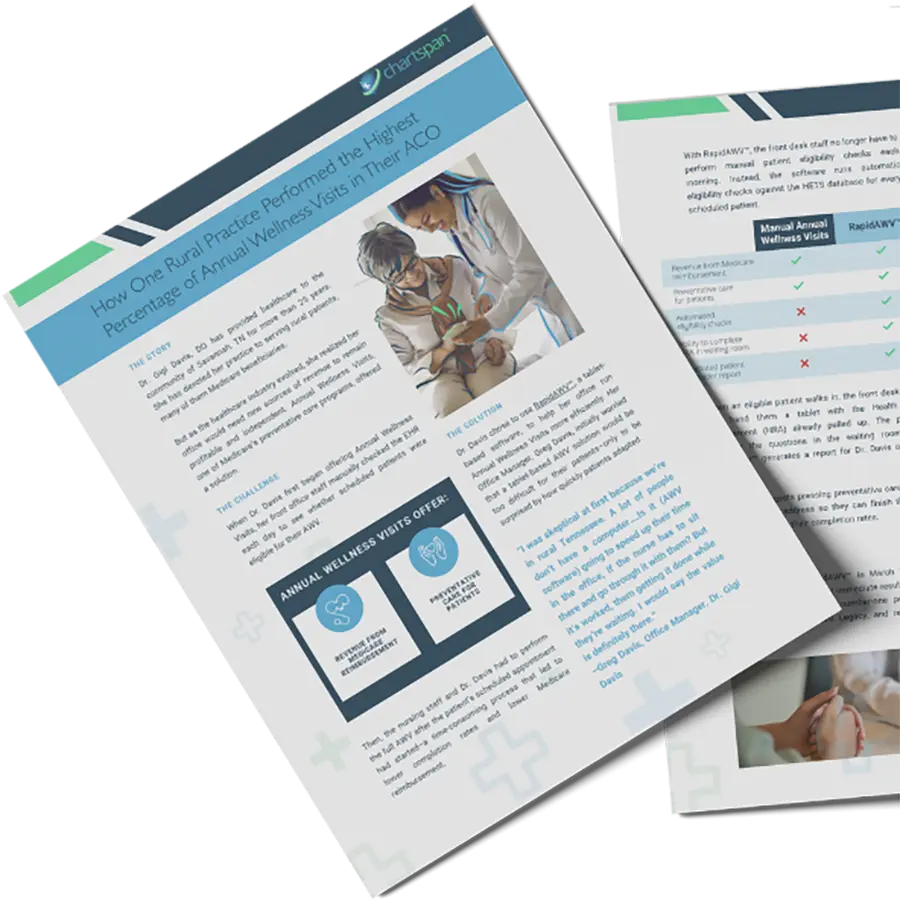
Talk with a ChartSpan Representative Today!
Our team is ready to help you improve patient care and outcomes.
Blog
Medicare’s Annual Wellness Visit Program Is on Life Support
By Jon-Michial Carter, CEO-ChartSpan
Have you ever dreamt of hosting a party only to have no one show up? Well, maybe not no one, but hardly anyone? That’s how policymakers at Medicare feel. Only, it’s not a dream.
In 2011, CMS (the policymakers at Medicare) used years of compelling patient research to validate the value of performing annual patient health risk assessments (HRA.) They launched a program to conduct annual HRAs for every Medicare patient, called Annual Wellness Visits (AWVs.) HRAs are questionnaires, completed by patients, that produce self-reported clinical information to be shared with their doctor. They include questions about recent vaccinations, medications, or health challenges a patient has encountered. HRAs are combined with a patient’s current vitals (height, weight, and blood pressure) to make up an Annual Wellness Visit. AWVs are not physical examinations. They are simply self-reported, patient questionnaires. AWVs are intended to be easy to complete and a collaborative way for a patient and doctor to discuss a patient’s preventative health. That’s truly important because we spend too much of our time in healthcare reacting, instead of proactively managing our health.
The data from the first nine years of the AWV program is remarkably good. It’s also remarkably bad. Let’s start with the good.
Cost Savings
The ultimate barometer of success in healthcare is how a particular program did or did not improve patient outcomes. Improving patient outcomes always, without exception, means a reduction in costs. A reduction in Medicare costs makes taxpayers happy since we are the ones funding Medicare.
A look at Medicare claims data for patients who receive AWVs versus those that do not show a significant decline in spending:
“An AWV was associated with significantly reduced spending on hospital acute care and outpatient services. Patients who received an AWV in the index month experienced a 5.7% reduction in adjusted total healthcare costs over the ensuing 11 months.”
- The American Journal of Managed Care - March 2019
Understand that in the big, bloated, single-digit margin world of healthcare, if you can bend the cost curve by a single percentage point you’ll be hoisted upon the shoulders of our industry and paraded down Main Street. Being able to reduce annual costs by nearly 6% for the portion of our population (elderly) in which we spend the most money is eye-popping.
Let’s break the numbers down further. The average annual spending “benchmark” of a Medicare patient is roughly $10,000 year. The term “benchmark” means the total amount of money that will be spent on providing healthcare services to a Medicare patient. For a patient that gets an AWV, the claims data shows annual costs are reduced by $570 per patient. If I’m a mid-sized health system with 25,000 Medicare patients and each one of them gets an AWV, the data imputes a total annual cost savings of $14,250,000. Gulp! And ponder this; there were 62,000,000 Medicare patients in the U.S., last month. If every Medicare patient got an AWV, the data shows taxpayers would save $35,340,000,000 per year. Double gulp!
But alas, the part about no one showing up for your party. Last year, four out of five Medicare patients failed to get an AWV. To be specific, 81% of all eligible Medicare patients did not receive the annual service. The reasons are mind-numbing.
ACO Cherry Picking
Many health systems and practices selectively choose which patients will and will not get an AWV. Under the pretense of something called “ACO attributable beneficiary,” cherry-picking which patients get an AWV is one of the most unethical practices I’ve ever witnessed in healthcare.
“ACO” stands for Accountable Care Organization. ACOs are generally management companies that bring a group of doctors, practices, and hospitals together to form a structured organization whose primary focus is to reduce healthcare costs. Medicare created the ACO program as a cost savings initiative, incentivizing participation by returning a portion of any cost savings achieved by an ACO, back to the ACO, and its members. Many ACOs and their members earn millions of dollars a year from Medicare.
I used to wonder why ACOs were so obsessed with conducting AWVs. Spending time reviewing Medicare claims data made the answer to that question abundantly clear. ACOs earn millions every year by ensuring patients get a preventative AWV and avoid hospitalizations and expensive procedures. They accomplish high AWV utilization rates through a creative and exhaustive focus on identifying eligible patients. But as it turns out, many ACOs and their practices only focus on a select group of patients called “attributable beneficiaries.”
Attributable beneficiaries are the patients Medicare assigns to a particular ACO and their member practices. The patients are counted towards the cost savings program in which ACOs participate. ACOs and their member practices work to identify which patients Medicare has attributed to them, and then, intensely, seek out these patients and conduct an AWV. What happens to all the patients of a particular doctor or practice that aren’t an “attributable beneficiary?” Claims data shows they are passed over and ignored. It’s shameful.
I know doctors, practices, and ACOs who don’t participate in this form of cherry-picking, but most do, as the data shows. Ignoring patients who would benefit from a preventative service like AWVs is indefensible. Why should we have to use millions in taxpayer dollars to get providers to do the right thing?
Patient Apathy
One of the reasons utilization of AWVs is so low is patient apathy. Many patients simply don’t care about preventative health. It’s sad, but a very true reason we have such a problem with healthcare spending in the U.S.
Patients want medications and they want whatever hurts to stop hurting. Very few will invest time in proactively managing their chronic conditions. It’s a battle that healthcare providers fight every day as they work hard to provide care to their patients.
A couple of years back, my company, ChartSpan, surveyed our seven largest customers regarding their AWV utilization rates. Our research found that 41% of all patients scheduled to come in for a preventative AWV visit, failed to show for their appointment. Practices were spending thousands on labor to schedule and facilitate these appointments, but two out of five patients were no-shows. How depressing.
Smart practices and providers have figured out scheduling AWVs is a money-losing proposition. Instead, they’ve smartly figured out how to turn a sick visit into a well visit, by introducing an AWV when a patient has come to the practice to get a prescription filled or is suffering from some sort of illness. AWV utilization rates for this approach are 200-300% higher than attempting to schedule AWVs.
Data, Data, and Data!
The hard part of managing AWVs is not the actual patient questionnaire. The biggest challenges come in managing the upstream and downstream data for AWVs.
Most practices struggle in identifying patients that are eligible for an AWV. Even if they can validate eligibility, they often don’t know which reimbursement code they are supposed to bill to Medicare. The only reliable way to identify eligible patients is real-time reconciliation of patient lists against Medicare’s claims database. Sadly, very few EHRs or AWV software vendors incur the associated data costs or provide this functionality to practices.
Patient data in EHRs is plagued with inconsistencies. Often, important demographic data is missing. Without certain data, patient eligibility cannot be determined. Again, almost no EHRs or AWV software vendors provide the functionality to reconcile the missing demographic data so that patient eligibility can be checked. The consequence is millions of elderly patients missing their annual AWV.
One of the most important promises of AWVs is the ability to aggregate all patient data and identify care caps. By collecting and sorting the self-reported, patient data from AWVs, practice Quality Managers and their providers can identify the most at-risk patients and provide risk interventions. Yet, very few AWV products in the marketplace do an adequate job of aggregating patient risk data. Every year, patients who need follow-up on care fall through the cracks because of inadequate analytics.
The Solution
With so much at risk, it’s time that the healthcare industry demands improvement. This includes providers, payers, and practices. The data is leading us in the direction we need to go. We must pay attention. Last year, only 19% of all Medicare patients got an Annual Wellness Visit that could have improved their health or saved their life. Let’s double that percentage this year, and the year after, until we’ve made AWVs pervasively common.
If you would like to respond or make a comment, feel free to email Jon-Michial at JonMichial.Carter@ChartSpan.com.
Subscribe for More Insights
Get valuable resources delivered straight to your inbox.
"*" indicates required fields





